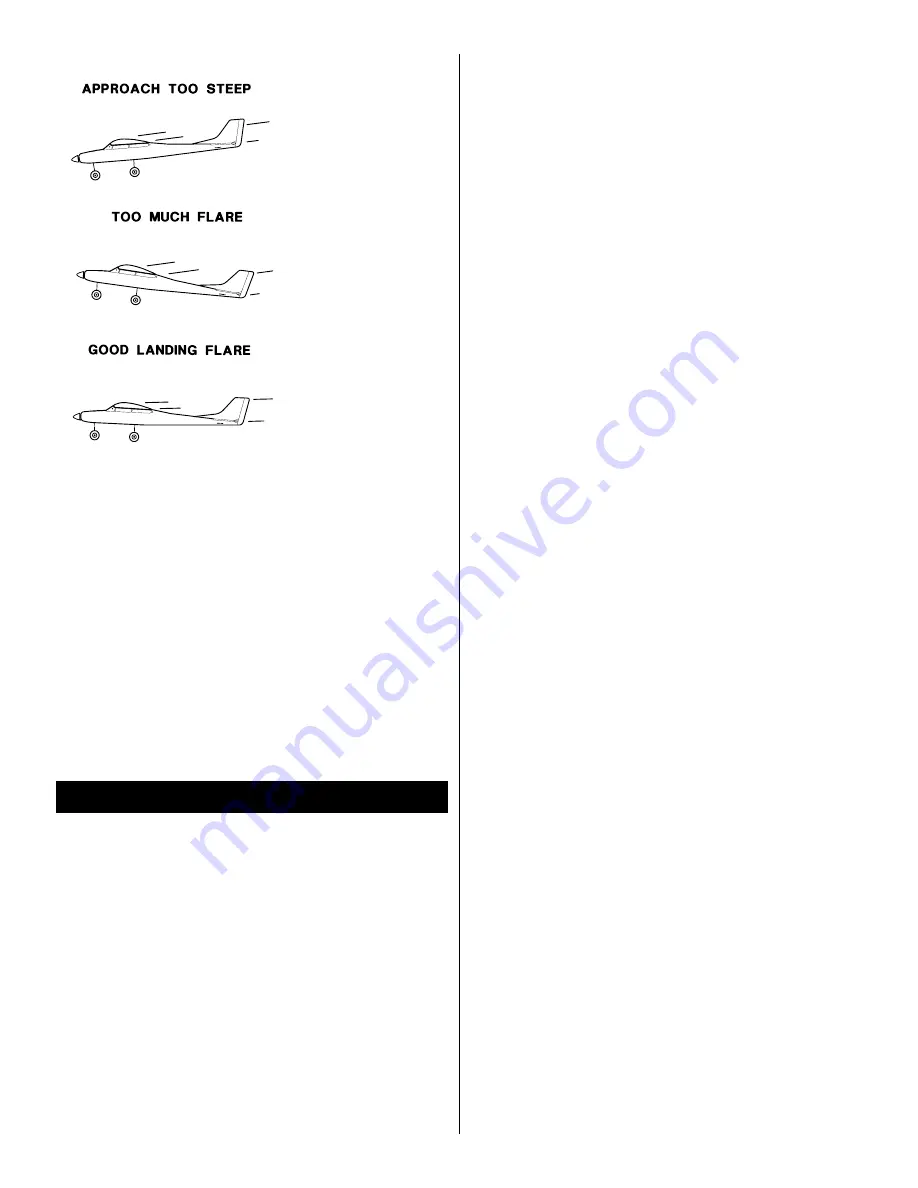
LANDING
When it’s time to land, fly a normal landing pattern and approach as
follows: Reduce the power to about 1/4 throttle and fly a downwind
leg far enough out from the runway to allow you to make a gentle
180° turn. As you make the turn into the wind for your final approach,
pull the throttle back to idle. Most trainer planes have a lot of lift, so
you will need a slow, reliable idle in order to achieve a nice, slow
landing. Allow the plane to keep descending on a gradual glide slope
until you are about 3 feet off the runway. Gradually apply a little up
elevator to flare for landing. You should apply just enough up
elevator to hold the plane just off the runway while the excess speed
bleeds off. The model should settle onto the runway for a slow,
slightly nose-high landing.
Good luck and have fun flying your model, but always stay in
control and fly in a safe manner.
...so you’ll know what they are talking about at the flying field.
Adverse Yaw - The tendency of an airplane to yaw in the opposite
direction of the roll. For instance, when right aileron is applied, the
airplane yaws to the left, thus opposing the turn. Adverse yaw is
common in trainer type airplanes having flat bottom wings. It is most
noticeable at slow speeds and high angles of attack, such as ring
takeoffs and when stretching a landing approach. Caused by the
unequal drag of the upward and downward deflection of the ailerons,
this undesirable trait can be minimized by setting up the ailerons
with Differential Throw or by coordinating the turns, using aileron
and rudder control simultaneously.
See differential throw.
Ailerons - Hinged control surfaces located on the trailing edge of the
wing, one on each side, which provide control of the airplane about
the roll axis. The control direction is often confusing to first time
modelers. For a right roll or turn, the right hand aileron is moved
upward and the left hand aileron downward, and vice versa for a left
roll or turn.
Angle Of Attack - The angle that the wing penetrates the air. As the
angle of attack increases so does lift and drag, up to a point.
ARF - A prefabricated model - Almost Ready to Fly.
Buddy Box - Two similar transmitters that are wired together with a
“trainer cord.” This is most useful when learning to fly — it’s the same
as having dual controls. The instructor can take control by using the
“trainer switch” on his transmitter.
Boring Holes In The Sky - Having fun flying with an R/C airplane,
without any pre-determined flight pattern.
CA (Abbreviation for “Cyanoacrylate”) - An instant type glue that is
available in various viscosities (Thin, Medium, Thick, and Gel). These
glues are ideal for the assembly of wood airplanes and other
materials. Note: Most CA glues will attack Styrofoam.
Carburetor - The part of the engine which controls the speed or
throttle setting and lean/rich mixture via setting of the needle valve.
CG (“Center of Gravity”) - For modeling purposes, this is usually
considered the point at which the airplane balances fore to aft. This
point is critical in regards to how the airplane reacts in the air. A
tail-heavy plane will be very snappy but generally very unstable and
susceptible to more frequent stalls. If the airplane is nose heavy, it
will tend to track better and be less sensitive to control inputs, but,
will generally drop its nose when the throttle is reduced to idle. This
makes the plane more difficult to land since it takes more effort to
hold the nose up. A nose heavy airplane will have to come in faster
to land safely.
Charge Jack - The plug receptacle of the switch harness into which
the charger is plugged to charge the airborne battery. An expanded
scale voltmeter (ESV) can also be plugged into it to check battery
voltage between flights. It is advisable to mount the charge jack in an
accessible area of the fuselage side so an ESV can be used without
removing the wing.
Charger - Device used to recharge batteries and usually supplied
with the radio if NiCd batteries are included.
Chicken Stick - A hand-held stick used to flip start a model airplane
engine.
Clunk - A weighted fuel pick-up used in a fuel tank to assure the
intake line is always in fuel.
Dead Stick - A term used to describe unpowered flight (glide) when
the engine quits running.
Differential Throw - Ailerons that are set up to deflect more in the
upward direction than downward are said to have Differential Throw.
The purpose is to counteract Adverse Yaw.
Dihedral - The V-shaped bend in the wing. Typically, more dihedral
causes more aerodynamic stability in an airplane, and causes the
rudder to control both the roll and yaw axis. This is why some
trainers and sailplanes require only 3 channels of radio control—i.e.,
having no ailerons.
Ding - Minor dent or damage to the structure. Also, a nick in a prop.
Dinged props must be replaced.
Down Thrust - Downward angle of the engine relative to the
centerline of the airplane. Down thrust helps overcome the normal
climbing tendency of flat bottom wings.
SOME MODELING TERMS & TRIVIA
Hold This Angle
Until Touchdown.
Danger of Stalling!
Release Elevator.
Apply Up Elevator.
22



































